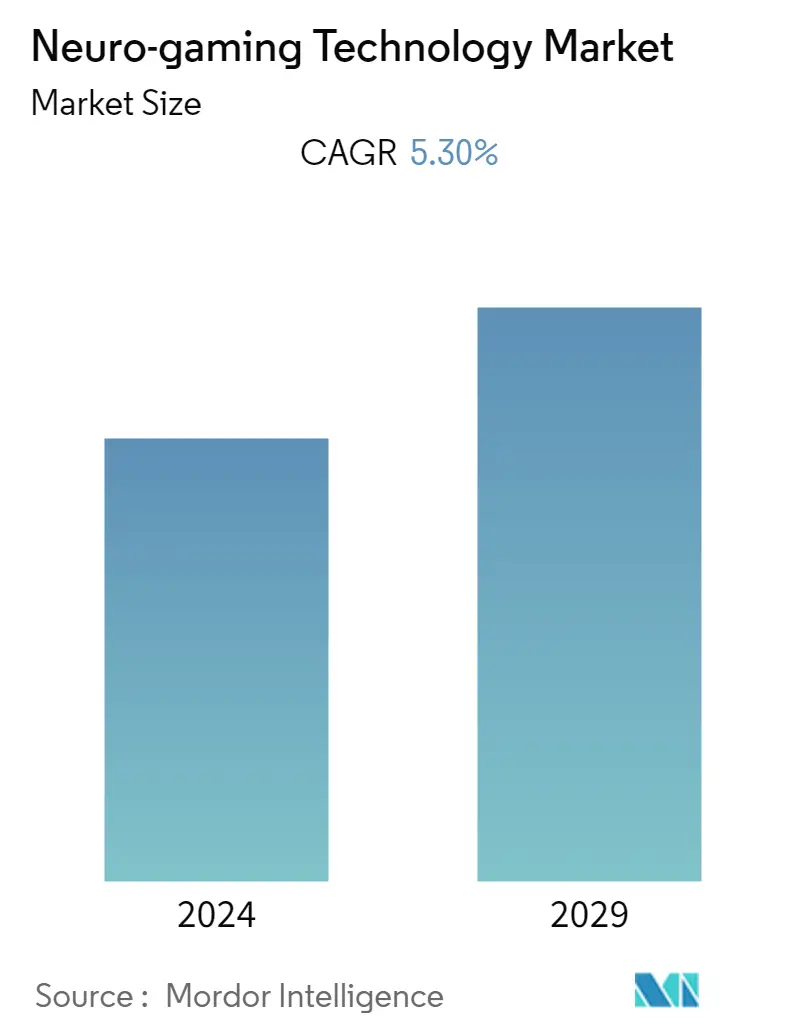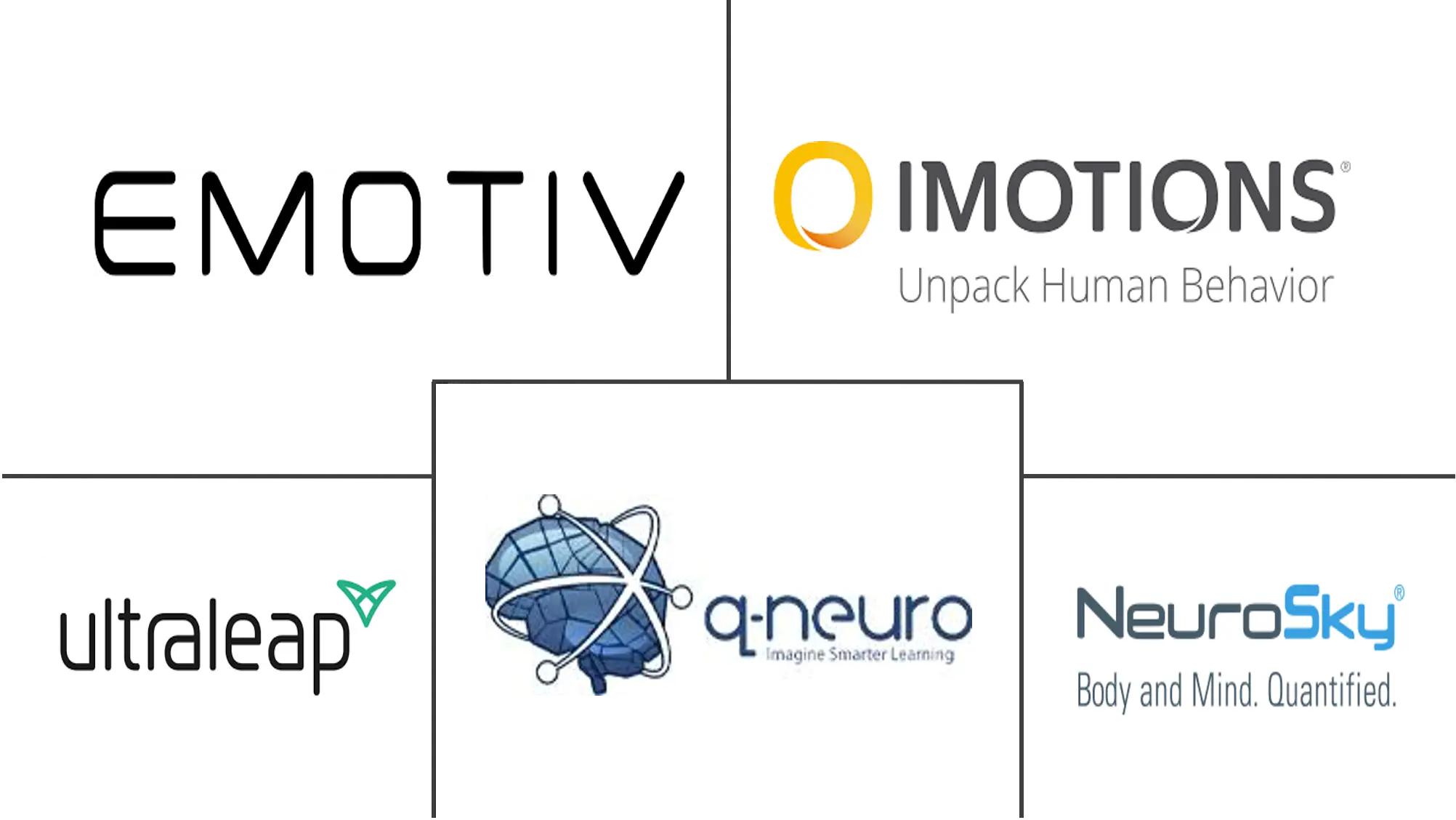Market Size of Neuro-gaming Technology Industry

| Study Period | 2019 - 2029 |
| Base Year For Estimation | 2023 |
| CAGR | 5.30 % |
| Fastest Growing Market | Asia-Pacific |
| Largest Market | North America |
| Market Concentration | Medium |
Major Players
*Disclaimer: Major Players sorted in no particular order |
Neuro-gaming Technology Market Analysis
The Neuro-gaming Technology Market is expected to register a CAGR of 5.3% over the forecast period. Neuro-gaming technology, advanced technology in gaming, involves the utilization of brain-computer interfaces (BCI), such as electroencephalography (EEG) technology, which allows users to interact with the game without using any traditional controller. In addition to entertainment, neuro-gaming technology also solves the purpose of healthcare and people's well-being by treating brain disorders such as Attention Deficit Hyperactivity Disorder (ADHD) and Post-traumatic Stress Disorder (PTSD). Also, increased internet penetration and the proliferation of smartphones have been driving the growth of the gaming industry, owing to further growth opportunities in the market studied.
- Latest technologies, such as Neuro-gaming technology, are being used to create advanced gaming hardware and software. Assisting in the process, many developers have been designing advanced games to help people improve physiological factors such as brainpower, health, and skills. Neurogaming may tap into brain waves, heart rate, pupil dilation, expressions, and emotions and can help advance gaming by enabling users to interact with a console directly through the nervous system and related physiological manifestations that can be converted into gaming control signals.
- The neuro-gaming technology is leveraging major technologies such as VR, AR, and haptic sensation systems for making new games. The gaming industry is continuously evolving with the adoption of the latest technologies to capture the attention and imagination of gamers across the world. Further, technological advancements to address the disorders in Children could drive the demand for the technology.
- Factors such as the increasing development of Brain-Computer Interfaces (BCIs), increasing usage of computers, laptops, and smartphones, and the rise in the adoption of smart devices act as some of the major drivers of the market. Besides, the surge in demand for more advanced technologies capable of adding multiple functionalities and features to the games is expected to drive further the demand for neuro-gaming technology.
- The culture of Neuro-gaming technology is still at an evolutionary stage. Hence, only a limited number of neuro games and a limited number of actions included in the game are available in the market. However, the rapid developments in the software and technologies could ensure that the neuro-games become more challenging with multiple actions.
- With a significant number of enterprises operating in the end-user industries such as healthcare, education, and entertainment impacted due to the lockdown restrictions amidst COVID-19, the market growth is expected to be challenged owing to a significant reduction in capital expenditure over the short term.
- Moreover, UTSA researchers launched the first worldwide Accessibility VR Game Jam, accessible to gamers with disabilities. But due to COVID-19, they worked to migrate the game jam to an online-only environment quickly. Further, post-pandemic, according to a recent study conducted by Verizon, gaming usage increased by 115% in the United States compared to the pre-pandemic period. The online gaming platforms and live streaming services also witnessed a record number of users throughout March and April. An increase in gaming traffic was witnessed during peak hours by 75% over the post-pandemic period.
Neuro-gaming Technology Industry Segmentation
Neurogaming Technology is a kind of gaming technology that uses Brain-computer interfaces (BCIs) such as EEG so that users can communicate with the game without applying a traditional controller. When applying Multiplayer mode, members can view the brain activity of other users, such as the user's changes in emotional state, heart rate, pupil dilation, brain waves, and gestures, which are combined to enrich the game experience. The report highlights the demand and ongoing trends in different offerings in terms of components, catering to the needs of certain end-users globally. The estimates and trends help project the driving factors and estimations for the forecast period.
The scope of the study includes the solutions and hardware (XR headsets, etc.) geared to integrate aspects related to the brain functioning and overall nervous system into a gaming workflow, to improve/enhance the user's functioning. Based on the internal mapping undertaken for the study, these vendors cater to the healthcare and education sectors, with a wide range of conditions such as ADHD, Dyslexia, and others. Taking this into view, current addressable market measures at a consolidated level will be studied, segmenting the market by component (hardware and software), by end-user industry (healthcare, education, and entertainment), and by geography (North America, Europe, Asia Pacific, Rest of the World) in the final study.
The market sizes and forecasts are provided in terms of value in USD million for all the above segments.
| By Component | |
| Hardware | |
| Software |
| By End User | |
| Healthcare | |
| Education | |
| Entertainment | |
| Other End Users |
| By Geography | |
| North America | |
| Europe | |
| Asia Pacific | |
| Rest of the World |
Neuro-gaming Technology Market Size Summary
The neuro-gaming technology market is poised for steady growth, driven by advancements in brain-computer interfaces and the increasing integration of technologies like virtual reality and augmented reality. This innovative sector combines gaming with neurological insights, allowing users to interact with games through brain activity, thereby offering both entertainment and therapeutic benefits. The technology is gaining traction in healthcare, particularly for treating conditions such as ADHD and PTSD, and is supported by the rising adoption of smart devices and increased internet penetration. Despite its potential, the market is still in an evolutionary phase, with a limited number of neuro-games available, but rapid technological advancements are expected to enhance the complexity and interactivity of these games.
The market landscape is moderately competitive, with key players focusing on product innovation and strategic collaborations to expand their offerings and market presence. Companies like Emotiv Inc., iMotions A/S, and NeuroSky Inc. are at the forefront, leveraging EEG and other technologies to create products that enhance cognitive functions and provide therapeutic benefits. The COVID-19 pandemic has accelerated the adoption of online gaming and streaming services, further boosting market growth. In regions like North America and Canada, the demand for neuro-gaming technology is increasing due to technological innovations and a growing awareness of its benefits. As the market evolves, it is expected to offer new opportunities for growth, particularly in addressing mental health challenges and enhancing learning experiences.
Neuro-gaming Technology Market Size - Table of Contents
-
1. MARKET INSIGHTS
-
1.1 Market Overview
-
1.2 Industry Stakeholder Analysis
-
1.3 Industry Attractiveness - Porter's Five Forces Analysis
-
1.3.1 Bargaining Power of Suppliers
-
1.3.2 Bargaining Power of Consumers
-
1.3.3 Threat of New Entrants
-
1.3.4 Threat of Substitutes
-
1.3.5 Intensity of Competitive Rivalry
-
-
1.4 Assessment of COVID-19 Impact on the Market
-
1.5 Games/Apps Landscape for Children with Neuro disabilities
-
1.5.1 Analysis on Impact of Games on Children with Neuro Disorders such as ADHD, ASD etc.
-
1.5.2 Training Programs and Games Reviewed and Suggested for Kids by Research Organizations and Healthcare Institutions
-
1.5.3 List of Game Developers such as Monte Cristo, that have developed games like Dino Island specifically designed to improve attention, working memory, and executive function in children with neurodevelopmental disabilities (Business Overview, Game Type, Popularity, etc.)
-
1.5.4 Overview of Educational Game Developers etc.
-
1.5.5 Role of the Latest Technologies in Developing the Ecosystem (Including, BCI, AR, VR, etc.)
-
-
-
2. MARKET SEGMENTATION
-
2.1 By Component
-
2.1.1 Hardware
-
2.1.2 Software
-
-
2.2 By End User
-
2.2.1 Healthcare
-
2.2.2 Education
-
2.2.3 Entertainment
-
2.2.4 Other End Users
-
-
2.3 By Geography
-
2.3.1 North America
-
2.3.2 Europe
-
2.3.3 Asia Pacific
-
2.3.4 Rest of the World
-
-
Neuro-gaming Technology Market Size FAQs
What is the current Neuro-gaming Technology Market size?
The Neuro-gaming Technology Market is projected to register a CAGR of 5.30% during the forecast period (2024-2029)
Who are the key players in Neuro-gaming Technology Market?
Emotiv Inc., iMotions A/S, Qneuro Inc., Ultraleap Ltd. and NeuroSky Inc. are the major companies operating in the Neuro-gaming Technology Market.

